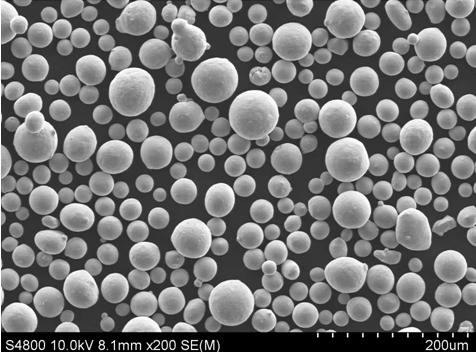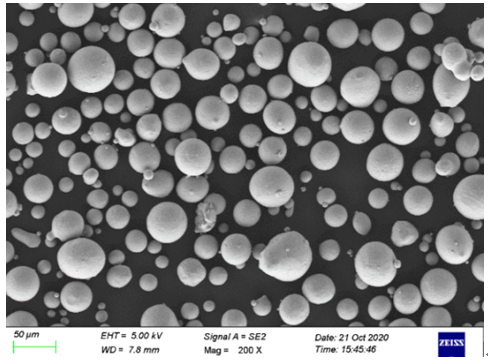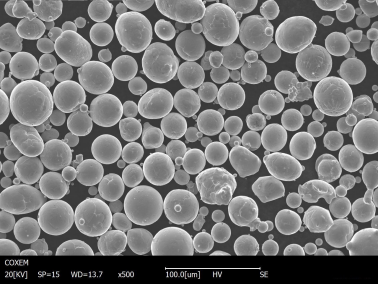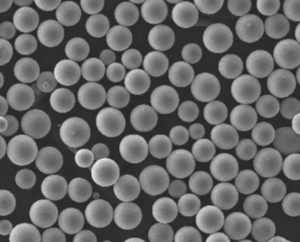Fusão por indução com eletrodo Atomização com gás inerte (EIGA) é um processo fascinante e altamente técnico usado na produção de pós metálicos de alta qualidade. Essa técnica é particularmente valorizada por sua capacidade de produzir pós com excelente pureza, distribuição uniforme de tamanho de partículas e morfologias específicas de partículas, que são essenciais em várias aplicações avançadas de fabricação. Neste guia abrangente, vamos nos aprofundar nos meandros da EIGA, explorar modelos específicos de pós metálicos e fornecer insights detalhados sobre suas propriedades, aplicações e vantagens.
Visão geral da fusão por indução com eletrodo Atomização com gás inerte
A fusão por indução de eletrodos e atomização com gás inerte é um processo que envolve a fusão de um eletrodo de metal usando aquecimento por indução, seguido pela atomização do metal fundido em partículas finas usando um gás inerte. Esse método é altamente considerado por produzir pós livres de contaminação, o que é crucial em aplicações como manufatura aditiva, metalurgia do pó e cerâmica avançada.
Principais recursos do EIGA:
- Pureza: O processo minimiza a contaminação, garantindo pós metálicos de alta pureza.
- Controle de tamanho de partícula: Permite o controle preciso da distribuição do tamanho das partículas.
- Partículas esféricas: Produz partículas esféricas, melhorando a fluidez e a densidade de empacotamento.
- Versatilidade: Pode ser usado com uma ampla variedade de metais e ligas.

Composição e propriedades dos pós EIGA
Compreender a composição e as propriedades dos pós EIGA é essencial para selecionar o material certo para aplicações específicas. A seguir, exploramos as composições e propriedades de vários pós metálicos produzidos com a EIGA.
Tipos e composições de pós EIGA:
| Pó metálico | Composição | Propriedades |
|---|---|---|
| Titânio (Ti-6Al-4V) | 90% Titânio, 6% Alumínio, 4% Vanádio | Alta resistência, leve, resistente à corrosão |
| Liga de níquel (Inconel 718) | 50-55% de níquel, 17-21% de cromo, 4,75-5,5% de nióbio, além de ferro, molibdênio e titânio | Resistência a altas temperaturas, resistente à corrosão |
| Aço inoxidável (316L) | 16-18% de cromo, 10-14% de níquel, 2-3% de molibdênio, equilíbrio de ferro | Resistente à corrosão, boas propriedades mecânicas |
| Liga de cobalto-cromo (CoCrMo) | 60-65% Cobalto, 26-30% Cromo, 5-7% Molibdênio | Alta resistência ao desgaste, biocompatível |
| Liga de alumínio (AlSi10Mg) | 85-90% de alumínio, 9-11% de silício, 0,2-0,4% de magnésio | Leve, com boas propriedades mecânicas, fundível |
| Cobre (Cu) | 99% de cobre | Excelente condutividade elétrica e térmica |
| Tungstênio (W) | 99% de tungstênio | Densidade muito alta, alto ponto de fusão |
| Liga de magnésio (AZ91D) | 90-93% de magnésio, 8-9% de alumínio, 0,2-1% de zinco | Leve, com boa capacidade de fundição |
| Aço para ferramentas (H13) | 0.32-0,45% de carbono, 4,75-5,5% de cromo, 1,1-1,75% de molibdênio, equilíbrio de ferro | Alta resistência ao desgaste, boa tenacidade |
| Alumineto de titânio (TiAl) | 45-48% de titânio, 48-51% de alumínio | Leve, resistente a altas temperaturas |
Características dos pós EIGA:
| Característica | Descrição |
|---|---|
| Morfologia da partícula | Esférico, melhorando a fluidez e a densidade de empacotamento |
| Pureza | Alta, devido à atmosfera de gás inerte que impede a oxidação e a contaminação |
| Distribuição do tamanho das partículas | Estreito e controlável, essencial para processos de fabricação precisos |
| Densidade | Altas densidades de tap e bulk, benéficas para técnicas de fusão de leito de pó |
| Área de superfície | Controlado para otimizar os processos de sinterização e fusão |
Aplicações dos pós EIGA
Os pós da EIGA encontram aplicações em vários setores, cada um aproveitando as propriedades exclusivas desses pós metálicos de alta qualidade. Abaixo está uma tabela detalhada que mostra diferentes aplicações.
Aplicações e usos dos pós EIGA:
| Setor | Aplicativo | Benefícios |
|---|---|---|
| Aeroespacial | Lâminas de turbina, componentes estruturais | Alta relação força/peso, resistência à temperatura |
| Médico | Implantes, próteses, aplicações odontológicas | Biocompatibilidade, resistência à corrosão |
| Automotivo | Componentes do motor, trocadores de calor | Leve e de alto desempenho |
| Eletrônicos | Tintas condutoras, dissipadores de calor | Excelente condutividade elétrica |
| Energia | Células de combustível, componentes de bateria | Alta eficiência e confiabilidade |
| Manufatura Aditiva | impressão 3D de geometrias complexas | Flexibilidade de design, redução do desperdício de material |
| Metalurgia do pó | Peças sinterizadas, rolamentos | Alta densidade, microestrutura uniforme |
| Revestimentos | Revestimentos por spray térmico, revestimentos resistentes ao desgaste | Propriedades de superfície aprimoradas, durabilidade |






Especificações, tamanhos, classes e padrões
Ao selecionar os pós EIGA para aplicações específicas, é fundamental entender as especificações, os tamanhos, os graus e os padrões associados a esses materiais.
Especificações e padrões para pós EIGA:
| Pó metálico | Faixa de tamanho de partícula (µm) | Notas padrão | Padrões relevantes |
|---|---|---|---|
| Ti-6Al-4V | 15-45, 45-90 | Grau 5 | ASTM F2924 |
| Inconel 718 | 15-45, 45-106 | AMS 5662 | AMS 5662, ASTM B637 |
| Aço inoxidável 316L | 15-45, 45-106 | ASTM F138 | ASTM A276, F138 |
| CoCrMo | 15-45, 45-106 | ASTM F75 | ASTM F75 |
| AlSi10Mg | 15-45, 45-106 | PT AC-43400 | EN 1706 |
| Cobre | 15-45, 45-106 | OFHC | ASTM B216 |
| Tungstênio | 15-45, 45-106 | W1, W2 | ASTM B777 |
| AZ91D Magnésio | 15-45, 45-106 | ASTM B93/B93M | ASTM B93/B93M |
| Aço para ferramentas H13 | 15-45, 45-106 | ASTM A681 | ASTM A681 |
| Alumineto de titânio | 15-45, 45-106 | Personalizado | ISO 5832-3 |
Detalhes de fornecedores e preços
Identificar fornecedores de boa reputação e entender os detalhes dos preços é fundamental para obter pós de EIGA de alta qualidade. Veja abaixo uma tabela com alguns dos principais fornecedores e preços indicativos.
Fornecedores e preços de pós EIGA:
| Fornecedor | Pó metálico | Faixa de preço (USD/kg) | Informações de contato |
|---|---|---|---|
| Tecnologias de superfície da Praxair | Ti-6Al-4V | $200 – $300 | Site da Praxair |
| Aditivo Carpenter | Inconel 718 | $150 – $250 | Site da Carpenter Additive |
| GKN Hoeganaes | Aço inoxidável 316L | $100 – $200 | Site da GKN Hoeganaes |
| Soluções HC Starck | CoCrMo | $200 – $300 | Site da HC Starck Solutions |
| ECKART América | AlSi10Mg | $50 – $100 | Site da ECKART |
| Produtos especiais de metal da AMETEK | Cobre | $50 – $100 | Site da AMETEK SMP |
| Advanced Powder & Coatings Ltd. | Tungstênio | $300 – $500 | Site da Advanced Powder & Coatings |
| Material avançado Zhongnuo | AZ91D Magnésio | $50 – $100 | Site da Zhongnuo |
| Kennametal | Aço para ferramentas H13 | $100 – $200 | Site da Kennametal |
| Metais ATI | Alumineto de titânio | $300 – $500 | Site da ATI Metals |
Comparação dos prós e contras dos pós EIGA
A avaliação das vantagens e limitações dos pós EIGA ajuda a tomar decisões informadas para aplicações específicas.
Vantagens e limitações dos pós EIGA:
| Vantagens | Descrição |
|---|---|
| Alta pureza | O EIGA minimiza a contaminação, produzindo pós de alta pureza. |
| Tamanho de partícula uniforme | Permite o controle preciso da distribuição do tamanho das partículas. |
| Partículas esféricas | Aprimora a fluidez e a densidade de empacotamento, essenciais para a fabricação de aditivos. |
| Faixa versátil de materiais | Pode produzir pós de uma ampla variedade de metais e ligas. |
| Baixo teor de oxigênio | A atmosfera de gás inerte reduz a oxidação, mantendo a integridade do material. |
| Limitação | Descrição |
|---|---|
| Custo | Os pós EIGA podem ser mais caros em comparação com outros métodos. |
| Complexidade | O processo requer equipamentos sofisticados e conhecimento especializado. |
| Volume de produção | Pode ser limitado no volume de pó que pode ser produzido em um único lote. |
| Consumo de energia | Alta necessidade de energia devido à fusão por indução. |
Insights detalhados e exemplos
Titânio (Ti-6Al-4V) vs. Inconel 718:
O titânio Ti-6Al-4V e o Inconel 718 são dois pós metálicos importantes usados em aplicações de alto desempenho. O Ti-6Al-4V, conhecido por sua alta relação resistência/peso e resistência à corrosão, é amplamente utilizado nos campos aeroespacial e biomédico. Por outro lado, o Inconel 718, com sua força superior em altas temperaturas e resistência à oxidação, é preferido para componentes aeroespaciais que operam em ambientes extremos. Ao comparar os dois, o Ti-6Al-4V é mais leve e mais adequado para aplicações sensíveis ao peso, enquanto o Inconel 718 oferece melhor desempenho em condições de alta temperatura.
Aço inoxidável 316L vs. liga de alumínio (AlSi10Mg):
O aço inoxidável 316L e a liga de alumínio AlSi10Mg são comumente usados na manufatura aditiva. o 316L é preferido por sua resistência à corrosão e propriedades mecânicas, o que o torna ideal para aplicações médicas e marítimas. Por outro lado, o AlSi10Mg, por ser leve e fundível, é excelente para aplicações automotivas e aeroespaciais em que a redução de peso é crucial. A escolha entre esses materiais geralmente se resume aos requisitos específicos da aplicação, com o 316L oferecendo durabilidade e o AlSi10Mg proporcionando economia de peso.
Liga de cobalto-cromo (CoCrMo) para aplicações médicas:
A liga de cobalto-cromo (CoCrMo) é amplamente utilizada em aplicações médicas, especialmente em implantes e próteses, devido à sua alta resistência ao desgaste e biocompatibilidade. A capacidade da liga de suportar o ambiente agressivo do corpo sem se degradar faz dela a melhor opção para implantes de longo prazo. Além disso, suas propriedades mecânicas são adequadas para aplicações de suporte de carga, garantindo a confiabilidade e a longevidade dos dispositivos médicos.

Perguntas frequentes
| Pergunta | Resposta |
|---|---|
| O que é fusão por indução com eletrodo e atomização com gás inerte? | O EIGA é um processo que envolve a fusão de um eletrodo de metal usando aquecimento por indução e a atomização do metal fundido em partículas finas usando um gás inerte. |
| Quais metais podem ser processados com o EIGA? | Uma ampla variedade de metais e ligas, incluindo titânio, níquel, aço inoxidável, cobalto-cromo, alumínio, cobre, tungstênio, magnésio, aço para ferramentas e alumineto de titânio. |
| Quais são os benefícios de usar os pós da EIGA? | Os pós EIGA oferecem alta pureza, tamanho de partícula uniforme, morfologia esférica e baixo teor de oxigênio, o que os torna ideais para aplicações avançadas de fabricação. |
| Como a EIGA se compara a outros métodos de produção de pó? | O EIGA oferece pureza e controle de partículas superiores em comparação com métodos como atomização de gás ou atomização de água, embora possa ser mais caro e complexo. |
| Quais são as aplicações comuns dos pós EIGA? | As aplicações incluem componentes aeroespaciais, implantes médicos, peças automotivas, eletrônicos, sistemas de energia, manufatura aditiva, metalurgia do pó e revestimentos. |
| Quais fatores devem ser considerados ao selecionar os pós EIGA? | Os principais fatores incluem os requisitos específicos da aplicação, as propriedades desejadas do material, a distribuição do tamanho das partículas, a pureza e o custo. |
| Os pós EIGA podem ser usados na manufatura aditiva? | Sim, os pós EIGA são altamente adequados para a manufatura aditiva devido à distribuição controlada do tamanho das partículas e à alta pureza, que melhoram a qualidade das peças impressas. |
| Qual é a faixa típica de tamanho de partícula dos pós EIGA? | Os tamanhos das partículas normalmente variam de 15 a 106 mícrons, dependendo da aplicação e dos requisitos. |
| Há alguma limitação para o uso dos pós EIGA? | As limitações incluem custos mais altos, complexidade do processo, volumes de produção limitados e alto consumo de energia. |
| Onde posso comprar os pós da EIGA? | Entre os fornecedores respeitáveis estão Praxair Surface Technologies, Carpenter Additive, GKN Hoeganaes, HC Starck Solutions, ECKART America, AMETEK Specialty Metal Products, Advanced Powder & Coatings Ltd., Zhongnuo Advanced Material, Kennametal e ATI Metals. |
Conclusão
Fusão por indução com eletrodo Atomização com gás inerte é uma tecnologia de ponta que desempenha um papel fundamental na produção de pós metálicos de alta qualidade. Sua capacidade de produzir pós com pureza excepcional, distribuição precisa de tamanho de partícula e morfologia esférica a torna indispensável em setores avançados de fabricação, como o aeroespacial, o médico e a manufatura aditiva. Ao compreender a composição, as propriedades, as aplicações e as vantagens dos pós EIGA, os setores podem aproveitar essa tecnologia para obter desempenho superior e inovação em seus produtos.
Seja você um engenheiro, pesquisador ou fabricante, este guia abrangente fornece o conhecimento e as percepções necessárias para navegar pelas complexidades dos pós EIGA e tomar decisões informadas para suas necessidades específicas.

